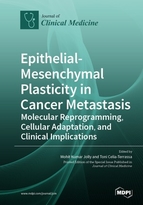Epithelial-Mesenchymal Plasticity in Cancer Metastasis: Molecular Reprogramming, Cellular Adaptation, and Clinical Implications
A special issue of Journal of Clinical Medicine (ISSN 2077-0383). This special issue belongs to the section "Oncology".
Deadline for manuscript submissions: closed (30 June 2019) | Viewed by 135675
Special Issue Editors
Interests: metastasis; mathematical oncology; systems biology; computational biology; phenotypic plasticity; cellular decision-making; cancer stem cells; epithelial-mesenchymal transition
Special Issues, Collections and Topics in MDPI journals
Interests: breast cancer; metastatic colonization; tumor microenvironment; cancer stem cells; mammary stem cells; cellular plasticity; dynamics of epithelial-to-mesenchymal transition and its reversion
Special Issue Information
Dear Colleagues,
Recent studies have highlighted that Epithelial-Mesenchymal Transition (EMT) is not only about cell migration and invasion, but also it can govern many other important facets such as immunosuppression, metabolic reprogramming, senescence-associated secretory phenotype (SASP), stem cell properties, therapy resistance and tumour microenvironment interactions. With an on-going debate about the requirement of EMT for cancer metastasis, an emerging focus on intermediate states of EMT and its reverse process Mesenchymal-Epithelial Transition (MET) offer new ideas for metastatic requirements and the dynamics of EMT/MET during the entire metastatic cascade. Therefore, we would like to initiate discussions on viewing EMT and its downstream signalling networks as a fulcrum of cellular plasticity, and a facilitator of adaptive responses of cancer cells to distant organ microenvironments and various therapeutic assaults. We hereby invite scientists who have prominently contributed to this field, and whose valuable insights gained over prolonged painstaking research, have led to the appreciation of Epithelial-Mesenchymal Plasticity as a more comprehensive mediator of adaptive response of cancer cells, eventually leading to huge implications in metastasis, drug resistance, tumour relapse, and patient survival.
Dr. Mohit Kumar Jolly
Dr. Toni Celia-Terrassa
Guest Editors
Manuscript Submission Information
Manuscripts should be submitted online at www.mdpi.com by registering and logging in to this website. Once you are registered, click here to go to the submission form. Manuscripts can be submitted until the deadline. All submissions that pass pre-check are peer-reviewed. Accepted papers will be published continuously in the journal (as soon as accepted) and will be listed together on the special issue website. Research articles, review articles as well as short communications are invited. For planned papers, a title and short abstract (about 100 words) can be sent to the Editorial Office for announcement on this website.
Submitted manuscripts should not have been published previously, nor be under consideration for publication elsewhere (except conference proceedings papers). All manuscripts are thoroughly refereed through a single-blind peer-review process. A guide for authors and other relevant information for submission of manuscripts is available on the Instructions for Authors page. Journal of Clinical Medicine is an international peer-reviewed open access semimonthly journal published by MDPI.
Please visit the Instructions for Authors page before submitting a manuscript. The Article Processing Charge (APC) for publication in this open access journal is 2600 CHF (Swiss Francs). Submitted papers should be well formatted and use good English. Authors may use MDPI's English editing service prior to publication or during author revisions.
Keywords
- Epithelial-Mesenchymal Plasticity
- Phenotypic switching dynamics and intermediate states
- Metabolic reprogramming
- Metastasis
- Therapy resistance and sensitivity
- Clinical evidence of EMT/MET in metastatic samples
- Epigenetic remodeling
- Upstream signaling pathways of EMT/MET
- Downstream signaling activated by EMT/MET
- New technologies to study cancer EMT/MET in vivo







